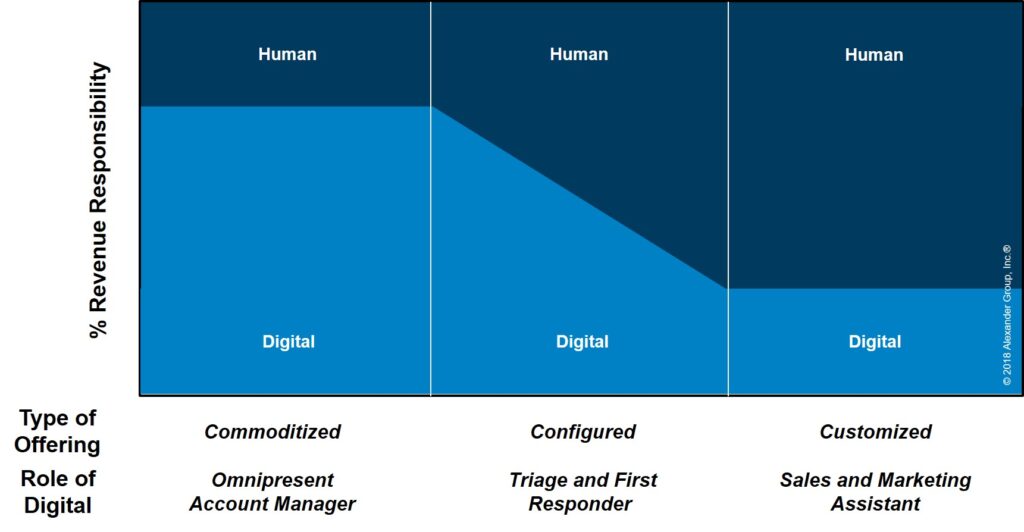Rethinking Revenue Growth: The Thing About Digital…

The Alexander Group recently held an executive summit event in London on the topic of digital as a sales channel, a bridge to customers and an enablement tool. Participants highlighted the need to clarify the definition of “digital,” the importance of having a back-end and front-end strategy, and how to appropriately “plug” a digital approach into a customer journey. There was no question about the need to increase digital involvement in revenue generation efforts. Instead, discussion centered on lessons learned and digital “bets” leaders are considering in the future.
Digital in Everything
First, one item of clarification: Digital in this context does not mean a tool. Digital, like any revenue team member, has a goal of delivering a message, providing persuasion for a buyer to take an action and, ideally, closing a sale. Tools, either off the shelf or custom-built, then come together in order to create the interaction and environment for a buyer to take action, rather than force fitting a buyer journey to a tool configuration.
More broadly, discussions of “this digital thing” do not cover whether a given sales process has a digital element. All revenue generation activities should include a digital element without exception. Customers expect this level of engagement and, more likely than not, use digital tools to research your company, your offerings and maybe even their account manager without your knowledge. No, leading revenue teams ask questions about how and where to involve a digital tool, asset or mode of communication rather than whether to involve it at all.
The nature of your offering has a key role to play in making a trade-off about how to balance a digital interaction with human intervention. The graphic below gives a visual for this interaction. Commodity offerings that the market and buyers have high familiarity with should have high digital inclusion. Configured offerings require some intervention from your revenue team to recommend the correct components supported by a robust digital approach to capture and store key buyer indicators. Customized solutions often have higher delivery risk, require buy-in from more stakeholders in an organization, and so require a more in-person persuasion to create success. Understanding how your revenue organization adds value in a selling situation helps to create the appropriate mix of digital and in-person interactions.
The Role Of “Digital” Depends on the Offering and Customer Risk Level
Digital Account Management
Fulfillment selling fundamentally requires a comparable product, brand awareness and availability in the moment when a buyer wants to make a purchase. Timely information and immediate access to your product or service creates the most value in this selling motion. Digital platforms and tools execute this extremely well. An e-catalogue system for a product-oriented business can always take an order. In this environment, we want to access, persuade and, ideally, fulfill for our customers in a scaled digital way. This does not need to mean “low touch,” but it does require repeatability and a high innate level of buyer confidence. The conditions for winning in this environment suit a digital revenue motion extremely well. Successfully executing this approach requires high-grade digital tools, resisting the temptation to intervene in individual sales opportunities and meeting implied SLAs. If we create value through immediate availability, we must deliver our product or service in the same ways. The front-end experience must match the back-end delivery or we will create an expectations gap with our customers. A revenue team member should contribute to this process in a programmatic and issue-resolution manner. Only customers who opt out of the process (and sometimes not even then) should speak directly to a team member. Instead, the digital presence acts as the primary channel with that channel managed actively, but remotely.
Digital Triage
Configured solutions generally use a limited number of “building block” offerings to meet a well-defined customer need that both the market and the sales team understands. The value delivered by a sales team in this environment comes from the ability to quickly understand, digest and respond to these customer needs. Digital’s ability to quickly collect and process information, provided both actively and passively, can create scale and support for a sales team. By using new data science tools, tracking site visits, asset downloads and other digital footprint metrics, the digital front end can classify a visitor and opportunity for a sales team member. Use of active functionality such as a chatbot can collect information on which an inside product specialist can follow up. The specialist could then use a digital collaboration solution to provide a video demonstration to the prospect on demand. This provides both a tailored experience to the buyer based on their expressed needs and behavior as well as scale to a presales engineer. Accounts and buyers that never could have supported this type of coverage suddenly have access to a type of expertise they would not have benefited from previously. This sort of access will drive growth with these customers, presuming the solutions themselves align well to a “virtual buy.”
Digital Support
Truly high-risk, customized solutions will continue to need face to face persuasion from sales teams. For this reason, we will not see a complete digitization of sales efforts any time soon. That said, even in this instance, digital has a role to play. New tools to “push” information and track which items customers buy help to shape conversations to their best outcomes. Lead tracking systems append data smoothly for sellers to use when they get in front of a customer. Internal tools can help to link and catalog value propositions to push pitch materials to sellers. CRM systems can deliver on-demand training videos for specific sales situations. These situations certainly have a personal touch where the best sales people will create a feeling of reliability and results, but a digital presence in the background acting as an “assistant” can put that sales person in the best possible situation. This sales motion looks very similar to most field or inside-based sales approaches today with new social media and technological tools to enable the seller.
Summit attendees agreed digital has a role to play in every sales motion and every sales opportunity. The depth, complexity and level of risk for the buyer significantly impacts how the digital presence will add value, but it does have a place to play in each situation. Companies that embrace digital as new way to sell and then align it to the appropriate situations will create outsized value for buyers and subsequent revenue growth.
_________
RELATED RESOURCES
